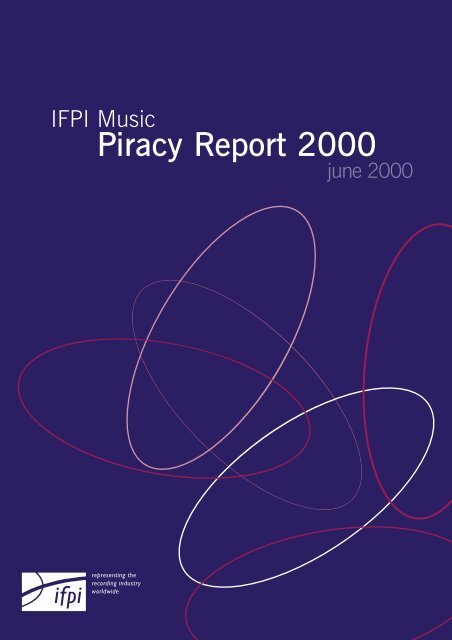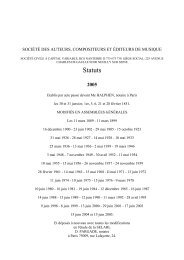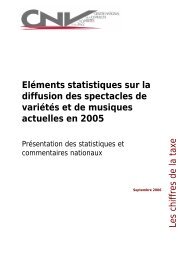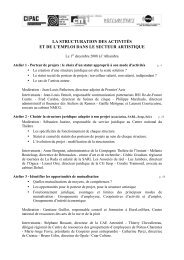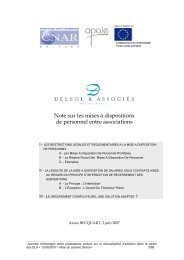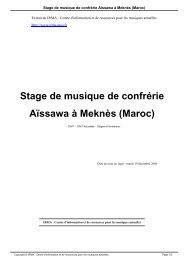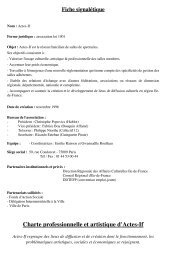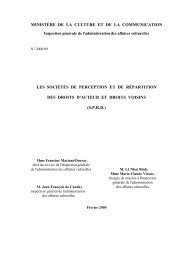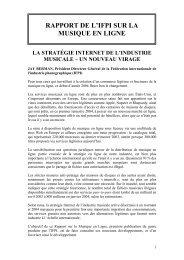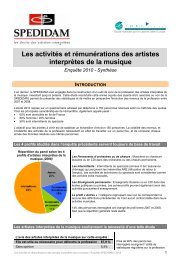Download Piracy Report 2000 - IFPI
Download Piracy Report 2000 - IFPI
Download Piracy Report 2000 - IFPI
You also want an ePaper? Increase the reach of your titles
YUMPU automatically turns print PDFs into web optimized ePapers that Google loves.
<strong>Piracy</strong> <strong>Report</strong> <strong>2000</strong><br />
<strong>IFPI</strong> Music<br />
june <strong>2000</strong>
<strong>Piracy</strong> <strong>Report</strong> <strong>2000</strong><br />
<strong>IFPI</strong> Music<br />
june <strong>2000</strong><br />
Introduction<br />
Music piracy is proliferating, driven by increased traffic in mass-produced audio<br />
CDs, an alarming surge in illegal sales of CD-Recordable discs and an exponential<br />
spread of pirate music files on the internet. Underpinning these trends has been a<br />
huge increase in global optical disc manufacturing capacity, far outpacing the<br />
growth of legitimate demand. There is also increasing evidence of the link between<br />
CD piracy and organised crime.<br />
Against this background, <strong>IFPI</strong>’s recently-created global anti-piracy structure has<br />
made substantial headway in 1999 and <strong>2000</strong>. Several modern plants, operating<br />
covertly, were put out of action in Latin America, Europe and South East Asia in<br />
1999. There have also been a number of ground-breaking cases of litigation against<br />
pirate operators, both physical and online.<br />
There have been some encouraging steps to fight piracy by a number of governments,<br />
with notable initiatives in Hong Kong, Bulgaria, parts of Latin America and by the<br />
European Parliament in Brussels. In most high-piracy territories, however, the<br />
response by government and enforcement agencies falls far short of what is required<br />
to tackle the problem.<br />
The spread of piracy, both of CDs and on the internet, is the greatest threat to<br />
the legitimate music industry. The future of a dynamic creative sector, of artists’<br />
livelihoods and of hundreds of thousands of jobs are all at stake. The need for<br />
governments worldwide to provide strong laws, effective enforcement and<br />
adequate deterrent penalties against piracy has never been greater.
Summary<br />
The global pirate music market is estimated to have totalled 1.9<br />
billion units in 1999, with an increase in CD piracy partly<br />
offsetting a worldwide decline in sales of illegal music cassettes,<br />
which fell to 1.4 billion units. Total sales of pirate music CDs<br />
topped 500 million units for the first time, with pressed pirate<br />
CDs (as opposed to CD-Rs) rising to an estimated 450 million<br />
units, from 400 in 1998.<br />
Pirate CD-Recordable discs are making a significant impact.<br />
<strong>IFPI</strong>’s first estimate is that pirate music CD-R sales amounted to<br />
at least 60 million units in 1999. Further research showed<br />
seizures worldwide of more than 1 million CD-R discs annually.<br />
This is unquestionably the tip of the iceberg. Total CD-R sales in<br />
all formats worldwide (audio and non-audio) more than doubled<br />
in 1999 to 1.5 billion units.<br />
The total value of the pirate music market in 1999, including<br />
sales of audio CDs, cassettes and CD-Rs, is estimated at $4.1<br />
billion – less than the estimated value in 1998, reflecting falling<br />
prices of illegal recordings and the decline in pirate sales of<br />
cassettes, particularly in Latin America, South East Asia and<br />
eastern Europe, where poor economic conditions prevailed.<br />
Underlying these trends was another year of dramatic growth in<br />
global optical disc manufacturing capacity. World capacity of all<br />
disc formats (including audio, CD-ROMs, CD-Rs and Video-CDs),<br />
rose 28% to 23 billion units in 1999. Over the past five years<br />
manufacturing capacity has increased by 340%. The number of<br />
known CD plants increased by 75 during the year, to 660.<br />
Optical Disc Manufacturing (all formats)<br />
million units<br />
25000<br />
<strong>2000</strong>0<br />
15000<br />
10000<br />
5000<br />
1994<br />
1995 1996 1997 1998 1999<br />
Demand Output Capacity<br />
Region by region, South East Asia remains a huge source of<br />
pirate CD production despite a fall in pirate sales in Hong Kong.<br />
In Europe, Ukraine poses the greatest threat to legitimate<br />
markets, although illegal manufacturing by disc plants in<br />
western Europe is also a substantial problem. Brazil and<br />
Paraguay stand out as the markets most under attack by CD and<br />
cassette pirates in Latin America.<br />
The following table lists those countries where known overcapacity<br />
is thought to be driving very high levels of pirate production:<br />
Current Estimated Pressing Capacity<br />
Country<br />
Current estimated<br />
capacity – all formats<br />
(million units)<br />
Taiwan 3,900 190<br />
Hong Kong 2,800 140<br />
China 680 620<br />
Singapore 490 50<br />
Macau 340 negligible<br />
Malaysia 280 50<br />
Czech Republic 90 25<br />
Russia 90 30<br />
Israel* 90 9<br />
Ukraine 70 5<br />
*Not including Palestine Authority<br />
Paraguay – there are believed to be underground CD plants, but no known<br />
legitimate ones<br />
Internet piracy spread dramatically during the year, through<br />
file-sharing services and on websites, but it is impossible to<br />
quantify the extent of the problem accurately. An estimate by<br />
Forrester Research puts the number of illegal downloads of<br />
music files at more than 1 billion in 1999. <strong>IFPI</strong> estimates that<br />
several million music files are available on the internet through<br />
file-sharing services such as Napster alone.<br />
CD <strong>Piracy</strong> and Organised Crime<br />
Total legitimate demand<br />
for all discs 1999<br />
(million units)<br />
Evidence of the link between music piracy and organised crime<br />
became apparent in the late 1990s as the CD format offered<br />
crime syndicates a simple, cheap and highly lucrative entry into<br />
a mass-scale illegal trade. In 1999 and early <strong>2000</strong> a number of<br />
cases were uncovered showing the convergence between CD<br />
piracy and other forms of serious and organised crime.<br />
They include the arrests by London police of members of a<br />
Russian crime ring charged with being involved in large-scale<br />
credit card fraud as well as in the traffic of pirate CDs; arrests by<br />
anti-mafia police in Italy and reports from the General Attorney<br />
of Naples that 100 Camorra gangs are involved in piracy as well<br />
as in drugs, firearms and extortion; and the crackdown by Dutch<br />
police against a US$50 million CD pirate ring in raids which<br />
seized firearms and large amounts of cash.<br />
Other seizures in the year showed the growing scale, sophistication<br />
and audacity of the international pirate traders – exemplified by the<br />
seizure in Frankfurt in January of half a million CDs manufactured<br />
in Ukraine and bound for Uruguay. The flood of international pirate<br />
traffic from South East Asia into Latin America, which began in<br />
1998, continued in 1999. A new phenomenon of wholly<br />
“underground” pirate CD plants also emerged for the first time in<br />
1999 (see next page). Illicit plants have been uncovered in Latin<br />
America, Asia and Europe. The trend reflects a move by the largely<br />
South East Asian-based pirate syndicates into local manufacturing<br />
in Latin America, complementing the existing direct exports.
The music industry responds:<br />
enforcement and litigation<br />
In 1998 <strong>IFPI</strong> established a new enforcement structure to match<br />
the global proliferation of CD piracy with a commensurate global<br />
response. That structure is now operating through a network of<br />
regional offices throughout the world. Its takes a “zero tolerance”<br />
approach to piracy, an approach that has reaped results.<br />
In November 1999 <strong>IFPI</strong>’s Main Board granted new resources<br />
to the enforcement structure, which will double the team’s<br />
headcount to around 50 in the year ahead. The expansion<br />
reflects the rapid growth of <strong>IFPI</strong>’s investigative and litigation<br />
activity. There are presently more than 100 cases involving<br />
cross-border pirate traffic under investigation, and more than<br />
20 cases of litigation in progress. <strong>IFPI</strong>’s anti-piracy resources<br />
now include a training section to work with enforcement<br />
authorities worldwide, a central forensic facility and state-ofthe-art<br />
intelligence processes.<br />
There were significant anti-piracy successes in 1999. Total<br />
seizures of optical discs were roughly on a par with 1998 at 60<br />
million. Some 15 million illegal CDs were seized in Latin<br />
America, largely sourced from South East Asia, taking the total<br />
to 34 million CDs seized in that region over the past two years.<br />
Even more significant in 1999 were the actions against entire<br />
underground CD plants in Holland, Philippines and Paraguay. Most<br />
spectacular were raids in Paraguay which uncovered two plants with<br />
an annual production capacity of some 50 million CDs. Syndicates<br />
based in Hong Kong were behind these illegal businesses.<br />
Enforcement successes have set in motion a series of litigation<br />
cases by <strong>IFPI</strong>, its national groups and its US affiliate, the RIAA.<br />
These have a major deterrent effect on future would-be<br />
infringers. In November RIAA won record damages of US$13.7<br />
million against Global Arts Productions and Danny Jordan who<br />
had engaged in back catalogue piracy internationally; <strong>IFPI</strong><br />
reached a US$1 million settlement – the largest in Europe –<br />
with a mastering plant in Switzerland over unauthorised<br />
mastering of <strong>IFPI</strong> members’ sound recordings for Bulgarian and<br />
Ukrainian clients during 1997 and 1998.<br />
Another litigation case, involving Golden Science, taken jointly<br />
with the Motion Picture Association (MPA), exemplifies the<br />
increasing cooperation between <strong>IFPI</strong> and other optical disc<br />
based industries. This civil litigation followed the largest ever<br />
seizure of optical discs in 1998, a massive 22 million units in<br />
a case involving charges of corruption on the part of a senior<br />
customs official.<br />
Government anti-piracy strategies:<br />
some highlights in 1999/<strong>2000</strong><br />
Controlling optical disc manufacturing is a key part of<br />
governments’ fight against piracy. There have been<br />
encouraging steps on this front. CD plant regulations have<br />
been introduced in Hong Kong and Bulgaria, and they are in<br />
preparation in Malaysia, India, Thailand and Macau.<br />
Hong Kong adopted legislation recognising copyright piracy<br />
as a serious and organised crime. This gives stronger powers<br />
to enforcement officers and the courts. A newly-formed<br />
Special Enforcement Team has focused on raids against<br />
pirate outlets in shopping centres and street-level stores.<br />
Meanwhile, Hong Kong Customs now has a substantially<br />
enlarged IPR enforcement team, with over 300 officers that<br />
are actively taking action against pirates.<br />
Poland belatedly adopted a new anti-piracy law which<br />
should help lower one of the highest piracy rates in eastern<br />
Europe; Italy, with the highest piracy rate in western Europe<br />
after Greece, failed to deliver on years of promises to enact<br />
a new anti-piracy law.<br />
The European Parliament adopted a report on the EC Green<br />
Paper on <strong>Piracy</strong> and Counterfeiting in the Single Market<br />
calling for increased co-operation between rights owners and<br />
authorities in dealing with cross-border piracy in the EU and<br />
eastern Europe, higher deterrent penalties and controls to<br />
prevent the manufacture of pirate CDs.<br />
Ukraine failed, in 1999 and to date, to tackle its mounting<br />
pirate manufacturing levels and needs both legislation and<br />
effective enforcement. Ukraine is one of a number of territories<br />
coming under strong pressure from the US government<br />
through the “Special 301” provisions of its trade legislation.<br />
Israel, also under scrutiny by the US government, has seen<br />
an alarming increase in piracy reflecting a breakdown in the<br />
enforcement process.<br />
There was no sign of improvement in China for the whole of<br />
1999. <strong>Piracy</strong> remained high and the figure released by the<br />
government suggested that the piracy rate was running as high<br />
as 90%. There were large-scale imports of pirated products<br />
from surrounding areas and the number of production lines has<br />
also increased. However, the government will be obliged to take<br />
more determined enforcement actions against pirates after the<br />
official WTO accession of China.<br />
Mexico enacted a new anti-piracy law in May 1999, allowing for<br />
better enforcement. This has helped reduce piracy in the country.
Internet <strong>Piracy</strong><br />
Internet piracy spread rapidly in 1999 and early <strong>2000</strong>, but it is too early to quantify the economic impact on the music<br />
market. Online piracy poses exactly the same threat as its physical equivalent to the creativity of artists and the investment of<br />
record producers. Potentially its impact is far greater than physical piracy. Internet piracy hampers the industry’s efforts to give<br />
consumers the benefits of a legitimate online music market. Record companies are making steady progress towards legitimate<br />
online business models, via a string of internet corporate investments and joint ventures, and through the technological forum<br />
of the Secure Digital Music Initiative (SDMI) and DVD-Audio.<br />
<strong>IFPI</strong>’s response to internet piracy is a combination of education of consumers and service providers and, where necessary,<br />
strategic litigation to remove infringing sites. A newly-formed dedicated internet piracy unit is developing a fully automated<br />
search and identification service, jointly with the Motion Picture Association (MPA).<br />
Legislation also plays a vital role in the fight against internet piracy. In the USA the Digital Millennium Copyright Act (DMCA)<br />
was adopted at the end of 1998. In Europe, the Copyright Directive was first proposed in 1997 to allow rights owners<br />
adequate rights and technical controls to protect their works. These legislative measures are the implementation vehicle for the<br />
WIPO Treaties, concluded in December 1996. They provide the legal foundation for the development of a legitimate online<br />
music industry internationally, and need to be ratified in 30 territories worldwide in order to come into force. By early <strong>2000</strong>,<br />
approximately 15 countries in Latin America, Asia, central and eastern Europe, and the US had already ratified the treaties.<br />
On the litigation front, the RIAA in the United States has spearheaded the industry’s response against infringers such as<br />
MyMP3.com and Napster which have tried to build large-scale businesses based on breaching copyright. These actions have<br />
attracted strong support from artists. Internationally, <strong>IFPI</strong> and its national groups have taken action to close down thousands<br />
of pirate sites. A global internet piracy campaign launched in October 1999 drew support from hundreds of artists worldwide.<br />
There have also been successful legal actions against internet service providers (ISPs) and content providers, notably:<br />
Belgium: a court decision against an ISP and against a website operator who offered on his site links to 25,000 illegally<br />
posted sound recordings<br />
France: Criminal litigation against two individuals who operated illegal link sites. This litigation ended with damages of<br />
US$15,000 and suspended prison sentences<br />
China: a settlement between several major record companies and the leading TV portal operator MyWeb which had<br />
provided links to infringing MP3 files. <strong>IFPI</strong> filed a lawsuit against MyWeb in December 1999<br />
Governments in the fight against piracy<br />
Music piracy erodes culture, destabilises legitimate economic<br />
activity and nurtures serious crime. It also robs governments of<br />
hundreds of millions of dollars in unpaid tax revenues and lost<br />
investment. Governments have a key role to play in supporting the<br />
efforts of the music sector and other copyright industries in the<br />
fight against piracy. Legislation and enforcement strategies in<br />
many territories are woefully mismatched<br />
to the scale of today’s international<br />
piracy business.<br />
One in three recordings<br />
worldwide is pirate<br />
36%<br />
Pirate<br />
Sales<br />
64%<br />
Legitimate<br />
Sales<br />
The recording industry’s two key priorities are:<br />
Adequate legislation: <strong>IFPI</strong>’s anti-piracy efforts have shown<br />
that in many jurisdictions intellectual property protection is<br />
inadequate. New legislation is also needed to give governments<br />
tighter controls over the operations of CD plants.<br />
Effective enforcement: in many territories, enforcement<br />
agencies are inadequately resourced and ineffectively managed<br />
to tackle piracy. In particular they are unequal to the global<br />
spread of today’s pirate networks. In many cases, fighting<br />
piracy is given a very low priority and penalties handed out by<br />
courts are often derisory.
High domestic piracy rates<br />
<strong>IFPI</strong>’s anti-piracy activities focus both on countries that are<br />
heavy producers of pirate CDs, and on territories where the<br />
levels of domestic piracy are excessively high. The following<br />
table provides information on the current priorities for <strong>IFPI</strong> in<br />
terms of domestic piracy:<br />
Current <strong>IFPI</strong> priorities in terms of<br />
domestic piracy levels in 1999<br />
Country <strong>Piracy</strong> (US$m) <strong>Piracy</strong> Level (Units)<br />
China 620 90%<br />
Russia 200 75%<br />
Brazil 180 50%<br />
Italy 115 25%<br />
Mexico 75 40%<br />
Taiwan 70 25%<br />
Poland 55 50%<br />
Israel 45 60%<br />
Greece 45 45%<br />
Hong Kong 25 50%<br />
Regional View<br />
North America<br />
The level of piracy over all in the region remains low, which is to<br />
a large extent due to an aggressive litigation strategy against<br />
pirate producers. In the US, the RIAA reported an increase in<br />
CD-R seizures. Internet piracy has become a priority issue with<br />
lawsuits filed against MP3.com and Napster.<br />
Europe<br />
Domestic piracy rates are considerably higher in eastern than in<br />
western Europe, with the notable exception of Italy and Greece.<br />
Finland has been increasingly affected by pirate product entering<br />
from Estonia, with piracy rising to over 10% of the market.<br />
CD-R piracy is a growing problem. In eastern Europe, piracy<br />
levels remain stubbornly high in Russia, Ukraine, CIS, the Baltic<br />
States, Bulgaria, Romania and Poland, restricting development<br />
of those developing markets.<br />
Asia<br />
Asia remains one of the high-piracy regions in the world both<br />
in terms of domestic piracy levels and production of pirate<br />
material. China saw almost 100% growth in the pirate market<br />
with a proliferation of different disc formats. There has been an<br />
improvement in Hong Kong (piracy down from 70% to 50% in<br />
1999) due to new laws and strong government action against<br />
pirate retail outlets. Other countries such as India, Pakistan and<br />
Malaysia also show very high piracy levels.<br />
Latin America<br />
CD piracy is estimated at about 30% throughout the region.<br />
Cassette piracy has virtually destroyed the cassette markets<br />
of countries such as Brazil. In 1999 the piracy rate in Brazil<br />
grew from 45% to 50% as a result of a deteriorating<br />
economy and inadequate enforcement measures by the<br />
government. The value of pirate sales was down due to<br />
lower pirate prices. Mexico saw a slight improvement to<br />
40% due to a new law and more effective enforcement<br />
action coupled with economic recovery. CD-R piracy is<br />
increasingly affecting Latin America, particularly Argentina,<br />
Colombia, Mexico and Peru.<br />
One of the biggest concerns for the recording industry<br />
remains Paraguay, used widely as a transhipment point by<br />
Asian organised crime groups for distribution throughout<br />
Latin America.<br />
Middle East<br />
Israel’s piracy sales value increased sharply in 1999 due to<br />
inadequate enforcement. The deteriorating situation also<br />
affects the territories of the Palestine Authority. The average<br />
level of piracy across the Middle East region was over 30%,<br />
running at a much higher rate in Egypt, Israel, Kuwait and<br />
Lebanon. <strong>Piracy</strong> levels fell in Bahrain and Oman and remain<br />
low in the UAE. Outside Israel, cassette sales continued to<br />
account for the bulk of pirate unit sales.<br />
Africa<br />
<strong>Piracy</strong> in South Africa and Zimbabwe is around 15%.<br />
Elsewhere in Africa, however, the figure is thought to be<br />
above 50%. CD-R piracy is a growing problem.<br />
Australasia<br />
<strong>Piracy</strong> in Australia and New Zealand has increased since<br />
the lifting of parallel imports restrictions, but remains at<br />
comparatively low levels.<br />
Note<br />
The value of pirate sales is calculated at local pirate prices,<br />
which fell in many of the high piracy regions – particularly<br />
Asia, Latin America and eastern Europe. If legitimate prices<br />
were applied, the value would be much higher.<br />
<strong>IFPI</strong> Music <strong>Piracy</strong> <strong>Report</strong> <strong>2000</strong><br />
was produced by the<br />
Communications and the Market<br />
Research Departments<br />
<strong>IFPI</strong> Secretariat<br />
54 Regent Street<br />
London W1R 5PJ<br />
Tel: +44 (0)20 7878 7900<br />
Fax: +44 (0)20 7878 7950<br />
Email: info@ifpi.org<br />
Web: www.ifpi.org
Level of domestic piracy 1999 (units)<br />
Over 50% 25-50% 10-25% Less than 10%<br />
North America<br />
Canada<br />
USA<br />
Europe Bulgaria Cyprus Finland Austria<br />
CIS (other) Greece Hungary Belgium<br />
Estonia Poland Italy Czech Republic<br />
Latvia Slovenia Denmark<br />
Lithuania<br />
France<br />
Romania<br />
Germany<br />
Russia<br />
Iceland<br />
Ukraine<br />
Ireland<br />
Netherlands<br />
Norway<br />
Portugal<br />
Slovakia<br />
Spain<br />
Sweden<br />
Switzerland<br />
UK<br />
Asia China Hong Kong Indonesia Japan<br />
Pakistan India Philippines<br />
Malaysia<br />
Singapore<br />
Thailand<br />
South Korea<br />
Taiwan<br />
Latin America Bolivia Brazil Argentina<br />
Central America Colombia Chile<br />
Ecuador<br />
Mexico<br />
Paraguay<br />
Uruguay<br />
Peru<br />
Venezuela<br />
Australasia<br />
Australia<br />
New Zealand<br />
Middle East/Turkey Israel Egypt Bahrain UAE<br />
Palestine Authority Kuwait Oman<br />
Lebanon<br />
Qatar<br />
Saudi Arabia<br />
Turkey<br />
Africa Kenya Ghana<br />
Nigeria<br />
South Africa<br />
Zimbabwe
<strong>IFPI</strong> Secretariat<br />
54 Regent Street<br />
London, W1R 5PJ<br />
Tel: +44 (0)20 7878 7900<br />
Fax: +44 (0)20 7878 7950<br />
www.ifpi.org


